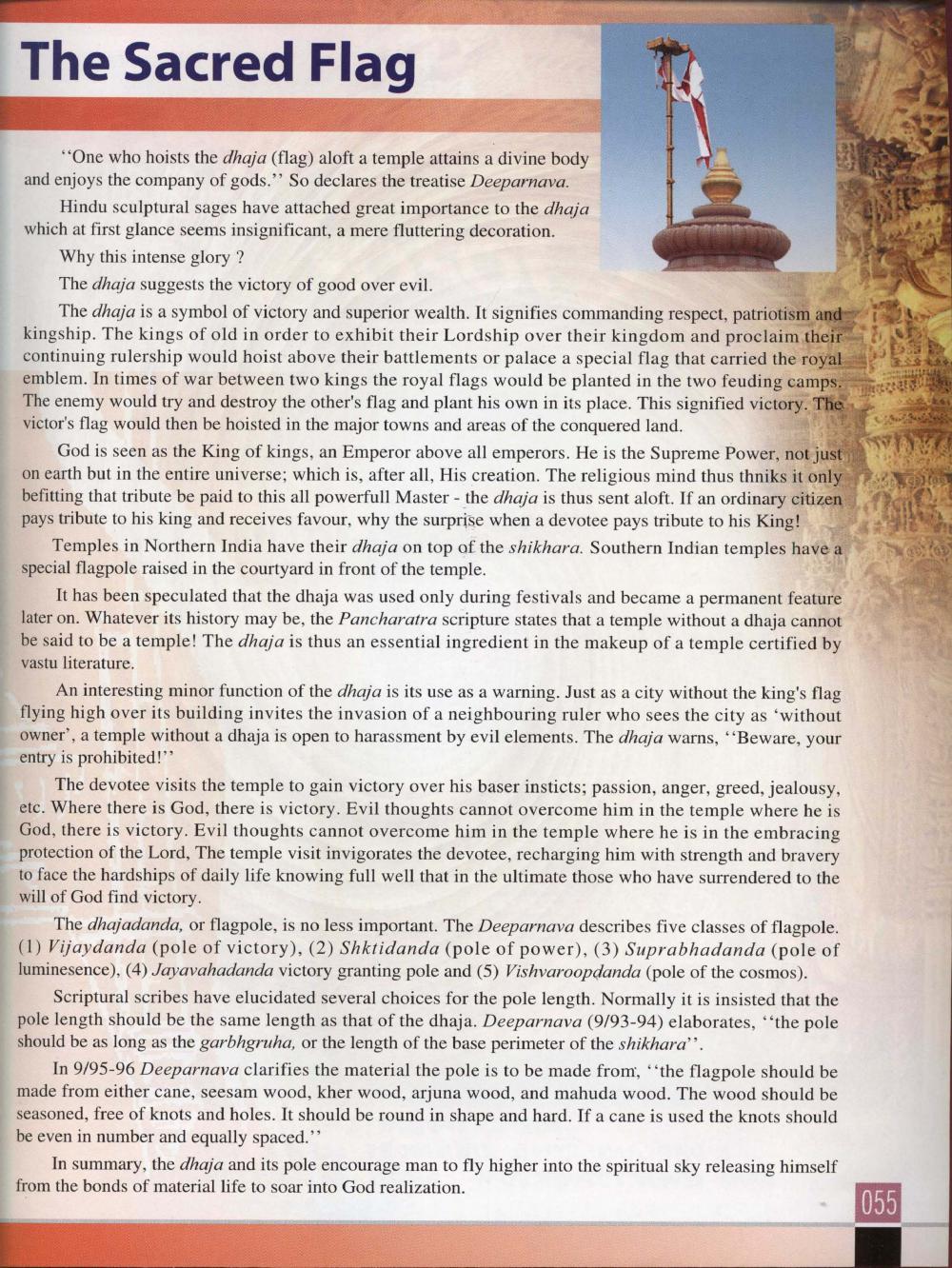________________
The Sacred Flag
SY
"One who hoists the dhaja (flag) aloft a temple attains a divine body and enjoys the company of gods." So declares the treatise Deeparnava.
Hindu sculptural sages have attached great importance to the dhaja which at first glance seems insignificant, a mere fluttering decoration.
Why this intense glory? The dhaja suggests the victory of good over evil.
The dhaja is a symbol of victory and superior wealth. It signifies commanding respect, patriotism and kingship. The kings of old in order to exhibit their Lordship over their kingdom and proclaim their continuing rulership would hoist above their battlements or palace a special flag that carried the royal emblem. In times of war between two kings the royal flags would be planted in the two feuding camps. The enemy would try and destroy the other's flag and plant his own in its place. This signified victory. The victor's flag would then be hoisted in the major towns and areas of the conquered land.
God is seen as the King of kings, an Emperor above all emperors. He is the Supreme Power, not just on earth but in the entire universe; which is, after all, His creation. The religious mind thus thniks it only befitting that tribute be paid to this all powerfull Master - the dhaja is thus sent aloft. If an ordinary citizen pays tribute to his king and receives favour, why the surprise when a devotee pays tribute to his King!
Temples in Northern India have their dhaja on top of the shikhara. Southern Indian temples have a special flagpole raised in the courtyard in front of the temple.
It has been speculated that the dhaja was used only during festivals and became a permanent feature later on. Whatever its history may be, the Pancharatra scripture states that a temple without a dhaja cannot be said to be a temple! The dhaja is thus an essential ingredient in the makeup of a temple certified by vastu literature.
An interesting minor function of the dhaja is its use as a warning. Just as a city without the king's flag flying high over its building invites the invasion of a neighbouring ruler who sees the city as 'without owner', a temple without a dhaja is open to harassment by evil elements. The dhaja warns, "Beware, your entry is prohibited!”
The devotee visits the temple to gain victory over his baser insticts; passion, anger, greed, jealousy, etc. Where there is God, there is victory. Evil thoughts cannot overcome him in the temple where he is God, there is victory. Evil thoughts cannot overcome him in the temple where he is in the embracing protection of the Lord, The temple visit invigorates the devotee, recharging him with strength and bravery to face the hardships of daily life knowing full well that in the ultimate those who have surrendered to the will of God find victory.
The dhajadanda, or flagpole, is no less important. The Deeparnava describes five classes of flagpole. (1) Vijaydanda (pole of victory), (2) Shktidanda (pole of power), (3) Suprabhadanda (pole of luminesence), (4) Jayavahadanda victory granting pole and (5) Vishvaroopdanda (pole of the cosmos).
Scriptural scribes have elucidated several choices for the pole length. Normally it is insisted that the pole length should be the same length as that of the dhaja. Deeparnava (9/93-94) elaborates, the pole should be as long as the garbhgruha, or the length of the base perimeter of the shikhara".
In 9/95-96 Deeparnava clarifies the material the pole is to be made from, the flagpole should be made from either cane, seesam wood, kher wood, arjuna wood, and mahuda wood. The wood should be seasoned, free of knots and holes. It should be round in shape and hard. If a cane is used the knots should be even in number and equally spaced."
In summary, the dhaja and its pole encourage man to fly higher into the spiritual sky releasing himself from the bonds of material life to soar into God realization.
055




